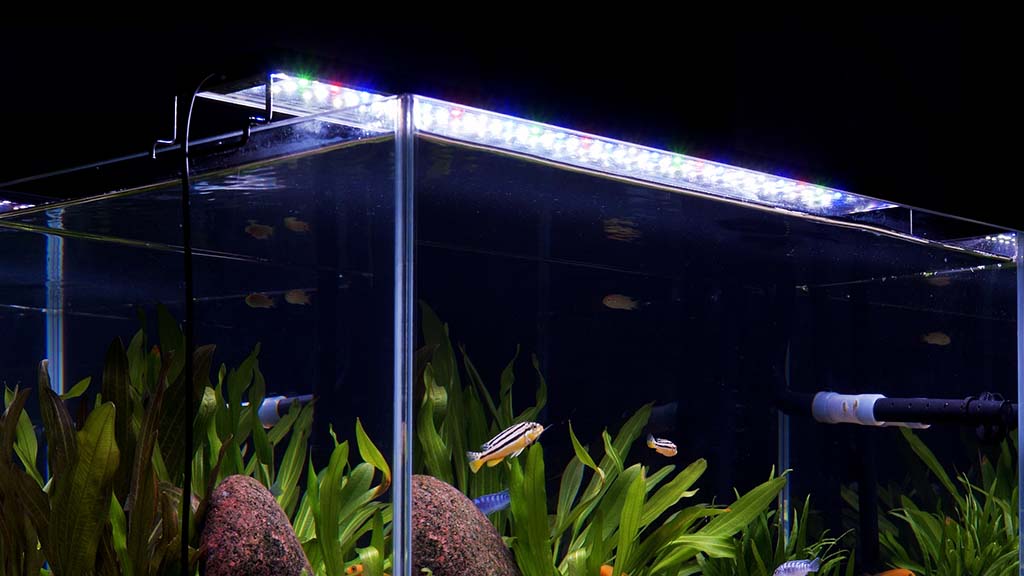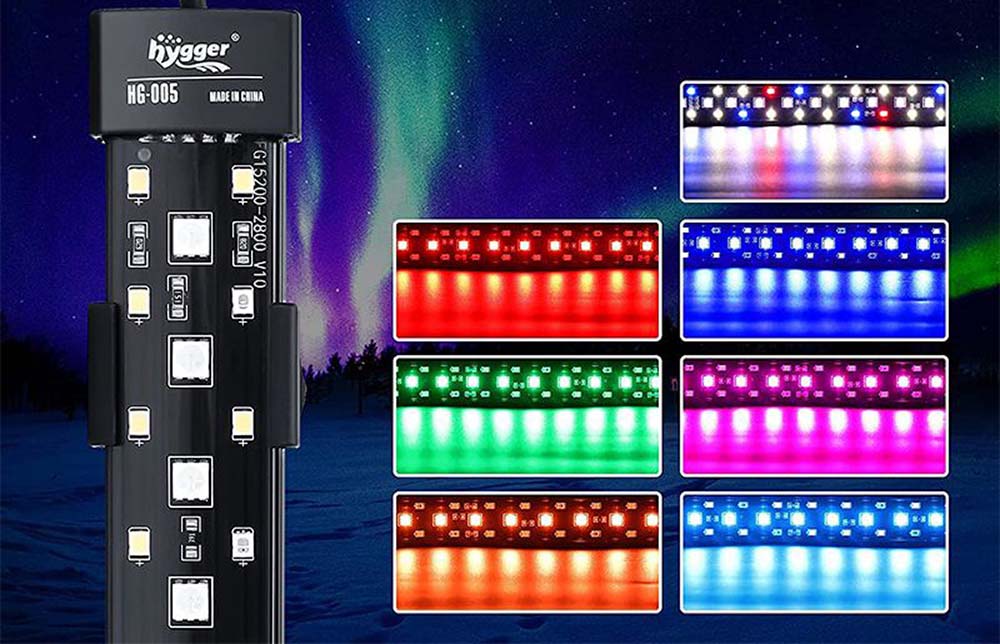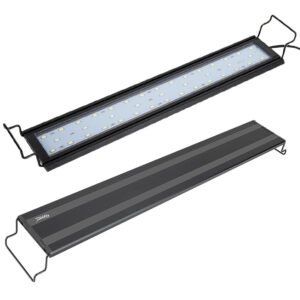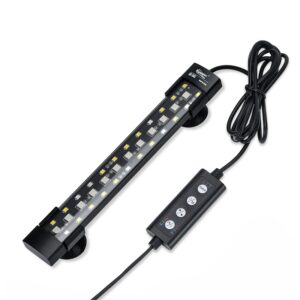Have you ever asked if you are bothering the fish that they need to hide when switching on the light, or if plants cannot grow in your tank? You’re not alone. The next factor that plays an important role in the overall health of your aquatic pets is light.
Content Table
Aquarium lighting explains the use of fluorescent and color spectrums of fish-only tanks, planted tanks, or community tanks. We then proceed to offer a comparison of two widely used Hygger lights, the hygger 005 and hygger 918, to assist you in selecting the right light for your aquarium.

Aquarium Lights for Fish & Aquatic Pets
The best aquarium lights depend on the type of fish and other aquatic pets you are going to have, as well as whether your aquarium contains live plants or not.
Here’s a general guideline.
- Freshwater fish only: It is best to use standard fluorescent lights or basic LED lights. These ensure most fish can see well enough to survive even when these lights are on.
- Live plants: If you have live plants, you will require a higher light intensity with a spectrum that will help the plants grow. Choose LED lighting specifically suited to planted aquariums. These lights will tend to have a higher PAR (Photosynthetically Available Radiation) value.
- Saltwater fish (reef tanks): Generally, the LED light source must be intense for saltwater fish, especially those that you tend to keep in reef tanks with corals; in this case, the spectrum must be natural sunlight. These lights will often have controls for brightness, color temperature, and time to simulate the day and night cycle.
Are Florescent Lights bad for my aquarium fish or Plants
Fluorescent lights are generally not bad for aquarium fish or plants, but it depends on a few things.
Type of fish: Many of the freshwater fish require little more than light for seeing and feeding. For these fish, standard fluorescent lamps can be used as adequate illumination to the fish’s environment.
Live plants: The intensity and spectrum of light produced by traditional fluorescent lamps may not be sufficient for the growth of some live plants. If you are in the process of setting up a planted tank, you might need fluorescent bulbs, since plants need light to synthesize.
Here’s a breakdown of the effects of fluorescent lights on fish and plants.
Fish
- Pros: Fluorescent light bulbs are inexpensive and deliver adequate illumination for most fish to observe their surroundings, act naturally as well as stay healthy.
- Cons: However, if it is too bright, it tends to have a negative impact by stressing some of the fish species.
Plants
- Pros: Some of the fluorescent bulbs could be used for the growth of low-light plants.
- Cons: Fluorescent are not ideal for many plants as they lack the intensity necessary for certain plants, particularly the high-light ones. The spectrum might not be the best for plant growth or development.
Here’s what might happen if you install fluorescent lights in your tank:
- For fish: If the lighting is not intensive and the fishes are the ones that do not require any specific conditions in terms of lighting, these fishes should be all right.
- For plants: Maybe low-light plants will be okay. Nonetheless, plants may appear to be suffering, underdeveloped, or stretched out due to lack of light or incorrect light spectrum.

What is the best color light for a fish tank?
Basic Fish Tank: Standard lights (fluorescent or LED) provide enough for most fish to see and thrive. Light color isn’t critical here, but a natural daylight look (around 6500 Kelvin) is pleasant.
Planted Tank: Here, light intensity matters more. Choose LEDs designed for planted tanks, with a spectrum rich in reds and blues (ideal for plant growth).
Community Tank: Balance fish and plant needs. A full-spectrum LED with adjustable settings (whites, blues, reds) lets you customize light for both.
Reef Tank: Aim for high-intensity LEDs mimicking natural sunlight. Look for a spectrum favoring blues and actinic blues (ideal for corals) with control over intensity and timers for a day/night cycle.
Submersible Light vs Blue-Red Light
hygger 005
More versatile with hygger 005 full spectrum light, submersible placement, and customizable lighting options. Ideal for planted tanks and achieving a natural look.
Pros:
- Submersible: This can be placed anywhere in the tank or hidden under the cover.
- Multiple Lighting Modes: Offers pre-programmed 24/7 cycle and DIY modes for customization.
- Adjustable Brightness and Timer: This lets you fine-tune light intensity and set lighting duration.
- Full Spectrum Light: Suitable for both fish and some plants.
Cons:
- Lower Light Output: This May not be enough for high-light plants.
- Limited Color Options: Only white, red, blue, and pre-set color cycles.
hygger 918
It is a simpler and more affordable option. Good for fish-only tanks and low-light plants. hygger 918 blue white red light is easier to adjust basic lighting settings.
Pros:
- Brighter Light: More powerful LEDs for better visibility and supporting low-to-mid light plants.
- Simpler Controls: Easier to adjust light settings with dedicated buttons.
- Multiple Mounting Options: Comes with both metal and plastic brackets for wider compatibility.
Cons:
- Non-submersible: Can only be mounted on the rim of the tank.
- Fewer Lighting Modes: Only has 3 basic color modes (white, white-blue-red, red-blue).
- No Pre-Programmed Cycle: Requires manual setting of timer and brightness.
- Shorter Warranty: Only has a 1-year warranty, compared to the 005’s unspecified warranty.

Which light is best for my fish tank
Based on the feature’s comparison of the hygger 005 and 918 lights:
- hygger 005 light: This is a better choice for planted tanks and fish-only tanks. It offers a full spectrum of light that promotes plant growth and allows customization for a natural day/night cycle.
- hygger 918 light: This is more suitable for fish-only tanks, especially those with low-light plants. It provides basic red, blue, and white lighting options but with a simpler setup.
Here’s a breakdown to help you decide.
- If you have live plants with higher light requirements, the hygger 005 is the way to go.
- If you have a fish-only tank or low-light plants, the hygger 918 is a good budget-friendly option.
- Consider the placement as well. If you prefer a submersible light, the hygger 005 is your only choice.
The Bottom line
As far as the choice of aquarium light for fish is concerned, it always depends on the inhabitants of the tank. For planted tanks, use a hygger 005 full-spectrum submersible light that’s perfect for encouraging the growth of plants. Basically, for a fish-only tank, there is no need for complicated light, a simple and bright light is all that is needed, such as the hygger 918 light, particularly for fully submerged plants. Thus, when opting for a light, one should take into consideration the intensity, spectrum, and position of the light.



Leave a comment